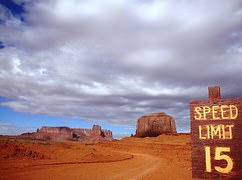Worried about driving a car in Australia? Don’t be, just learn a little about what it’s like to drive in Aus and you’ll be fine.
The good news is vehicles drive on the left in Australia so that’s one thing you don’t have to worry about when you tackle Aussie roads for the first time. Other factors you might find useful are covered in this next article. Before you drive a vehicle through the outback, read these tips and gain a little inside knowledge.
Seatbelt rules
The law in Australia states you must wear a seatbelt when you are driving a car. Any passengers inside the vehicle must wear a seatbelt too and small children under the age of 7 must be clipped into a suitable restraint system that’s appropriate for their size and weight. Adhere to this law just as you would in the UK. Fail to put your seatbelt on and don’t be too surprised if you see a police Holden flashing its lights at you from behind.
Speed limits

Keep your eye on the speedometer when you take to Australian roads. The limits are 50 kilometres in built up areas and 100 kph on freeways and major highways. Speed limits are clearly marked so look out for signs just like you would back in the UK. Speed cameras are common, both static and mobile, and red light cameras are also in operation so get ready to slow down as you are approaching a green light.
Journey times
One thing you quickly realise when you drive in Australia is how much distance there is between cities. This is a vast, remote landscape. Go from Sydney to Perth for example and you’ll cover 4159 kilometres along the National Highway taking 40 hours to complete the journey! So you need to be prepared for journey times and plan routes well in advance. Keep the car topped up with fuel and take plenty of water along for the ride. It’ll get hot during the day and can be extremely cold during the night.
Road trains

One of the common sights you’ll discover as you journey across Australian highways are huge road trains which are basically trucks towing unfeasibly large loads. Modern multi-trailer rigs can be over 150ft in length. Overtake them and it’s going to take a while so make sure you have enough space and time to commit to overtaking manoeuvres to avoid a head-on collision. Watch out for buffering as you pass the road train too. The sudden rush of wind can take you by surprise.
Travelling through the outback
If your journey takes you through remote areas of the outback make sure you tell somebody about your plans and give them an approximate time of how long the trip will take. You could leave a route plan with local police and this way if your car breaks down or you experience difficulties and don’t arrive at your destination at a set time search parties will know where to find you. If you do manage to break down stay with the vehicle, people will find you more quickly if you do.
Watch out for wildlife

Kangaroos are a common sight on remote Australian roads so be extra careful when you are driving on highways through the outback. Hit a kangaroo at speed and it’ll cause serious damage to your car. This problem gets worse at night. Animals are attracted to car headlights after sundown so drive with extra caution during the hours of darkness, plough into a kangaroo and you’ll certainly know about it. Look for warning signs at the side of the road which tell you this is a kangaroo zone.
Driving in Australia is pretty much essential due to the sheer size of the continent. Ship your vehicle overseas and these driving tips should help you navigate your way safely along Aussie roads.

